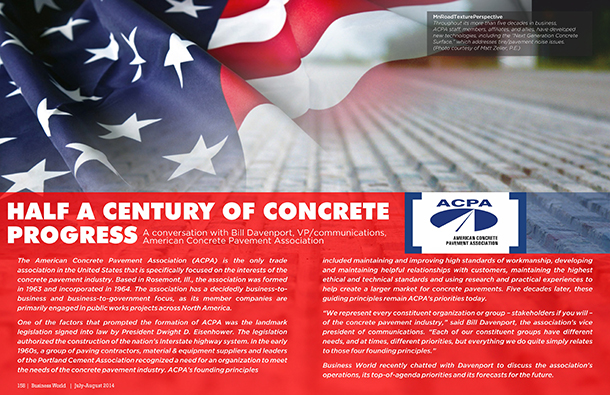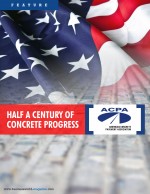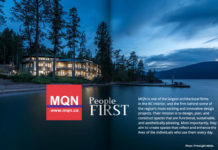
A Half-Century of Concrete Progress
A conversation with Bill Davenport, VP/communications, American Concrete Pavement Association

The American Concrete Pavement Association (ACPA) is the only trade association in the United States that is specifically focused on the interests of the concrete pavement industry. Based in Rosemont, Ill., the association was formed in 1963 and incorporated in 1964. The association has a decidedly business-to-business and business-to-government focus, as its member companies are primarily engaged in public works projects across North America.
 One of the factors that prompted the formation of ACPA was the landmark legislation signed into law by President Dwight D. Eisenhower. The legislation authorized the construction of the nation’s Interstate highway system. In the early 1960s, a group of paving contractors, material & equipment suppliers and leaders of the Portland Cement Association recognized a need for an organization to meet the needs of the concrete pavement industry. ACPA’s founding principles included maintaining and improving high standards of workmanship, developing and maintaining helpful relationships with customers, maintaining the highest ethical and technical standards and using research and practical experiences to help create a larger market for concrete pavements. Five decades later, these guiding principles remain ACPA’s priorities today.
 “We represent every constituent organization or group – stakeholders if you will – of the concrete pavement industry,†said Bill Davenport, the association’s vice president of communications. “Each of our constituent groups have different needs, and at times, different priorities, but everything we do quite simply relates to those four founding principles.â€
 Business World recently chatted with Davenport to discuss the association’s operations, its top-of-agenda priorities and its forecasts for the future.
BUSINESS WORLD: Talk to me a little bit about the operation of the association as an entity – in terms of staff, how many people do you have working for you?
BILL DAVENPORT: We are the national association for the concrete pavement industry. We work very closely with regional and state chapter affiliates throughout the United States and Canada to provide leadership at both the national and local levels. Together, this very formidable force provides a range of services that include technical support, promotion, advocacy and research.
BUSINESS WORLD: How many members do you have in the nationwide organization?
 DAVENPORT: We have about 400 members, with most being companies that employ multiple employees.
BUSINESS WORLD: In terms of the entities that make up that 400, is there a most-frequently recurring sort of one? Large company? Small company: What do you deal with most often?
 DAVENPORT: We represent large, medium and small companies, as well as individual members. We have a diverse membership base that includes cement companies, contractors, equipment/material suppliers, consultants, academia and several other categories. We like to say about our membership that anybody who has involvement, interest and passion for concrete pavement is eligible to be a member of the association.
BUSINESS WORLD: Are there any other nationwide organizations that are trying to appeal to the same members that you are? Maybe competition isn’t the right word, but that are maybe competitive in a sense with yours?
 DAVENPORT: Not in terms of representation of the concrete pavement industry. As I mentioned earlier, we are a federation comprised of the national association and our chapter/state paving association affiliates.
I should also add that we work closely with other allied organizations, including the Portland Cement Association and the National Ready-Mix Concrete Association. Both associations represent different aspects of the cementitious or concrete materials that go into our product.
In addition to that, we have two technology partners. One is called the National Concrete Pavement Technology Center, in Ames, Iowa. This is a third-party research and technology entity for the cement and concrete industries. We also enjoy a very close technical working relationship with the International Grooving and Grinding Association (IGGA), whose members are involved in a wide range of activities linked to restoring pavements, or what we call CPR (concrete pavement restoration). IGGA members are engaged in pavement surface texturing and a range of other services that impart safety and performance features. These processes are applied to new pavements, but are also essential to restoration and maintenance of existing pavements. These restorative techniques not only help extend the life of pavements; they also improve the investment value of tax dollars and other monies used to build and maintain our transportation infrastructure.
BUSINESS WORLD: Are there state or regional associations affiliated with yours that cover all 50 states? Do you have one in each state? Or are some of them grouped together?
 DAVENPORT: We have representation at the local level in most of the contiguous United States, but there are areas where we are presently not represented locally. Nationally and locally, we represent about 70 percent of mainline paving that’s done in the United States. By mainline paving, we are referring to highways, airports, and major roadways, but our members are also involved in projects of various size and scale. We are also involved in industrial pavements, as well as projects that involve technologies such as roller-compacted and pervious concrete. Although we’re not represented locally in every state, we represent the majority of what’s being paved and rehabilitated.
BUSINESS WORLD: Are there certain issues or priorities, or concerns that the members are talking about that get relayed through the main desk, through your office, that they want answers about or that they’re concerned with?
 DAVENPORT: Unequivocally, I would say that the number one issue on many peoples’ minds these days is funding.
There are two issues tied to this. One is the passage of a long-term reauthorization. In recent years, we’ve seen the legislation delayed, resulting in extensions and a short-term program reauthorization. One of the challenges of this is that short-term solutions create uncertainties and challenges in planning projects, and this makes it difficult for contractors and others in industry to make long-term investments in capital improvements, equipment, etc. Our hope is that we can again see a five- or six-year program that meets the critical needs of our nation’s surface transportation systems.
Closely tied to the issue of a long-term program is the fate of the Highway Trust Fund (HTF), which is the primary funding source for the transportation construction. We and many other organizations are working closely with Congress to resolve these issues and find long-term, sustainable solutions.
Highways, airports, roadways, and other pavements are vital to commerce and other business, both internationally and domestically. If we as a nation are going to remain competitive, we have to invest in the construction of new facilities, while also rehabilitating and preserving what we have in place now. Unfortunately, without long-term reauthorization of the transportation legislation, and without solutions to the federal funding picture, we simply cannot keep up with the challenges associated with normal wear and tear; increased traffic; heavier loads on highways; and other issues that threaten our system.
BUSINESS WORLD: As far as your membership, and ways that you as an association go about engaging them, what sorts of things have worked or resonated most often – is it events? Is it publications?
 DAVENPORT: Publications are certainly one resource we offer, but in a larger sense, one of our greatest resources is information. In recent years, we’ve been keeping pace with the digital age, and have disseminated information via our website (and microsites); web and smart phone apps; and other digital delivery methods. The digital age has had a profound effect on the way we deliver information, and this includes technical resources, training & education programs, problem solving resources, and a wealth of other resource. The digital age has enabled us to create some powerful tools, including our Concrete Overlays Explorer and Roller Compacted Concrete Explorer, two web resources that allow contractors, agencies/owners, consultants; and others with the ability to view current projects, photos, and very specific details. We update both resource regularly, and I believe these powerful resources would be difficult to replicate outside of the digital realm. The digital realm is essential to the way we do business, but we still offer some traditional resources, including some printed publications, classroom-style training, and other resources that our members and public agency/owner customers have come to expect.
BUSINESS WORLD: Five years from now, what do you think will occur? What are you hoping will occur? What are the priorities for the association? You mentioned the long-term highway funding, but are there other things as well?
 DAVENPORT: One of the keys to our success in recent years is the use of thin-concrete overlays to repair distressed pavements. We’ve had this technology for many years, and we see it being used for all types of pavements, including concrete, composite, and asphalt. In recent years, the use of concrete overlays on asphalt pavements has become more prevalent. We attribute some of this to the volatility in oil prices, and because asphalt is a derivative of oil processing, and just as we’ve seen oil prices increase, so too, have we seen the prices of asphaltic oil rise. We also see greater efficiencies in hydrocarbon processing, which means a higher percentage of high-value products, or said another way, less asphaltic oil available.
We are continuing to look for solutions that will help the state agencies and contractors place thinner sections of concrete overlays. The goal is providing the greatest possible value and return on investment of infrastructure investment dollars.
Sustainability is another focal point for ACPA. Concrete offers superior sustainability benefits, and so, we continue to support research, while also educating the marketplace about these benefits.
BUSINESS WORLD: You mentioned specifically the long-term highway funding and getting things straightened out in Washington. In your own expert opinion and heart of hearts, do you think something is going to get done? Are you optimistic? Is it an administration thing? If Congress and the White House are on the same side of the aisle, will things get done a little easier? How do you see that going?
 DAVENPORT: We’re optimistic about it. The administration has been, in the past few months, really pushing hard to find solutions to the Highway Trust Fund, and at the time of this interview, it appears some solutions, whether temporary or long-term, may be close at hand.
I think most members of Congress would acknowledge that highways, roadways and airports are extremely important to their constituents. Our nation’s transportation infrastructure is of course the means by which people get from point A to point B. Beyond the personal mobility aspects, our transportation infrastructure is a key to competitiveness in the global marketplace. There are safety and security aspects, too.
We’re acutely aware of the many challenges the nation is facing, but we cannot continue to ignore our surface transportation infrastructure, which continues to fall into further disrepair. Our system suffers from capacity issues; road-user delays; safety concerns; and other issues.
Nations that invest in their transportation infrastructure tend to be the ones that are leading the world in terms of business, commerce, defense and more.
As a nation, we cannot continue to remain a leading-edge, 21st century nation with highways and other facilities that were designed for our needs in the mid- to late-20th century. We’ve got to modernize. We’ve got to make that investment, or we’re going to see the nation’s stature decline and put us in a very vulnerable situation on many different fronts.
This may seem like a grim prognostication, but we remain hopeful that our elected officials will seize the opportunity to provide the policy and funding solutions that not only serve business and industry, but also benefit the traveling public across the nation.








